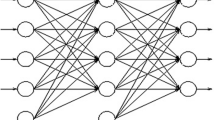Abstract
The soil properties are considered to be the important parameter related to the soil. There are different factors associated with it so that the proper results can be generated. Shear strength is considered to be the resistance internally present and applied for the forces which are external in nature. The other parameters are also involved for the calculation of the strength of soil. It is determined in laboratory using sophisticated equipment and is found to be associated with errors. Alternative such as the empirical correlations are considered to be valid for particular range. With the advent of computational technics, mathematical, numerical and artificial intelligence are explored for determination of shear strength. The artificial neural network is the technique where the prediction of the different soil properties is to be obtained. The properly collected data of different soil samples are then given as input to ANN Technique. It is very much necessary to predict the strength of the soil as there are numerous applications including construction, testing, sports, agriculture, military, etc. The different parameters are to be considered for the proper relationship to be obtained. The present paper is related to the review which has been carried out on the use of the artificial neural network in the strength calculation of the soil.
Access this chapter
Tax calculation will be finalised at checkout
Purchases are for personal use only
Similar content being viewed by others
References
Abu-Farsakh MY, Mojumder MAH (2020) Exploring artificial neural network to evaluate the undrained shear strength of soil from cone penetration test data. Transp Res Rec 2674(4):11–22
Dungca JR, Galupino JG (2017) Artificial neural network permeability modeling of soil blended with fly ash. Geomate J 12(31):77–82
Erzin Y, Rao BH, Patel A, Gumaste SD, Singh DN (2010) Artificial neural network models for predicting electrical resistivity of soils from their thermal resistivity. Int J Therm Sci 49(1):118–130
Erzin Y, Gumaste SD, Gupta AK, Singh DN (2009) Artificial neural network (ANN) models for determining hydraulic conductivity of compacted fine-grained soils. Can Geotech J 46(8):955–968
Ferreira EC, Milori DMBP, Ferreira EJ, Da Silva RM, Martin-Neto L (2008) Artificial neural network for Cu quantitative determination in soil using a portable laser induced breakdown spectroscopy system. Spectrochimica Acta Part B: Atomic Spectrosc 63(10):1216–1220
Hanandeh S, Ardah A, Abu-Farsakh M (2020) Using artificial neural network and genetics algorithm to estimate the resilient modulus for stabilized subgrade and propose new empirical formula. Transp Geotech 24:100358
Kalantary F, Kordnaeij A (2012) Prediction of compression index using artificial neural network. Scien Res Essays 7(31):2835–2848
Keshavarzi A, Sarmadian F, Omran ESE, Iqbal M (2015) A neural network model for estimating soil phosphorus using terrain analysis. The Egyptian J Rem Sens Space Sci 18(2):127–135
Kiran S, Lal B (2016) Modelling of soil shear strength using neural network approach. Electron J Geotech Eng 21(10):3751–3771
Mozumder RA, Laskar AI (2015) Prediction of unconfined compressive strength of geopolymer stabilized clayey soil using artificial neural network. Comp Geotech 69:291–300
Bunyamin SA, Ijimdiya TS, Eberemu AO, Kolawole JO (2018) Artificial neural networks prediction of compaction characteristics of black cotton soil stabilized with cement kiln dust. J Soft Comput Civ Eng 2(3):50–71
Ozturk M, Salman O, Koc M (2011) Artificial neural network model for estimating the soil temperature. Can J Soil Sci 91(4):551–562
Sungheetha A, Sharma R (2021) Fuzzy chaos whale optimization and BAT integrated algorithm for parameter estimation in sewage treatment. J Soft Comput Paradigm (JSCP) 3(01):10–18
Lin C-J, Nan-Jing W (2021) An ANN model for predicting the compressive strength of concrete. Appl Sci 11(9):3798
Karthigaikumar P (2021) Industrial quality prediction system through data mining algorithm. J Electron Inf 3(2):126–137
Pratibha C, Reddy KM, Bharathi L, Manasa M, Gandhiraj R (2019) Simulation of dual polarization radar for rainfall parameter and drop size distribution estimation. In: International conference on ıntelligent computing, ınformation and control systems. Springer, Cham, pp 424–433
Salahudeen AB, Sadeeq JA, Badamasi A, Onyelowe KC (2020) Prediction of unconfined compressive strength of treated expansive clay using back-propagation artificial neural networks. Nigerian J Eng 27(1)
Priyadarshee A, Chandra S, Gupta D, Kumar V (2020) Neural models for unconfined compressive strength of Kaolin clay mixed with pond ash, rice husk ash and cement. J Soft Comput Civ Eng 4(2):85–102
Ali B, Rahman MA, Rafizul IM (2016) Prediction of California bearing ratio of stabilized soil using artificial neural network. In: Proceedings of the 3rd ınternational conference on civil engineering for sustainable development (ICCESD 2016)
Salahudeen AB, Sadeeq JA (2019) California bearing ratio prediction of modified black clay using artificial neural networks. In: Book of proceedings, West Africa built environment research (WABER) conference, Accra, Ghana, pp 268–281
Vakili AH, Davoodi S, Arab A, Selamat MR (2015) Use of artificial neural network in predicting permeability of dispersive clay treated with lime and pozzolan. IJSRES 3(1):23–37
Pham BT, Nguyen MD, Bui KTT, Prakash I, Chapi K, Bui DT (2019) A novel artificial intelligence approach based on multi-layer perceptron neural network and biogeography-based optimization for predicting coefficient of consolidation of soil. Catena 173:302–311
Rao RMP, Rao HS (2012) Prediction of compressive strength of concrete with different aggregate binder ratio using ANN model. Int J Eng Res Technol 1(10):1–10
Park HI, Kim YT (2011) Prediction of strength of reinforced lightweight soil using an artificial neural network. Eng Comput
Shahin MA, Jaksa MB, Maier HR (2001) Artificial neural network applications in geotechnical engineering. Australian Geomech 36(1):49–62
Author information
Authors and Affiliations
Corresponding author
Editor information
Editors and Affiliations
Rights and permissions
Copyright information
© 2022 The Author(s), under exclusive license to Springer Nature Singapore Pte Ltd.
About this paper
Cite this paper
Wankhade, R.R., Durge, P.V. (2022). Literature Review in Artificial Neural Network for the Strength Calculation of Soil. In: Geetha, K., Gonzalez-Longatt, F.M., Wee, HM. (eds) Recent Trends in Materials. Springer Proceedings in Materials, vol 18. Springer, Singapore. https://doi.org/10.1007/978-981-19-5395-8_11
Download citation
DOI: https://doi.org/10.1007/978-981-19-5395-8_11
Published:
Publisher Name: Springer, Singapore
Print ISBN: 978-981-19-5394-1
Online ISBN: 978-981-19-5395-8
eBook Packages: Physics and AstronomyPhysics and Astronomy (R0)




